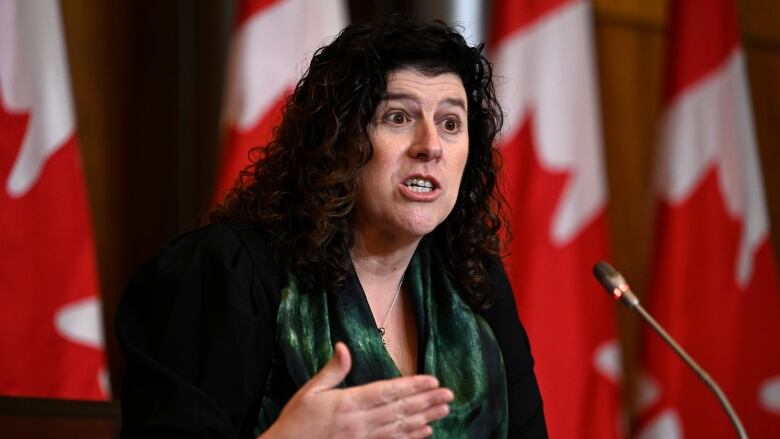Canada falling behind on connecting rural areas to high-speed internet: report
Connectivity gap raises questions of equality as more services move online, audit says

The government's efforts to connect rural parts of the country to high-speed internetare falling short, Canada's auditor general says in a report tabled Monday whichwarns that the gapbetweencities and everywherecould lead to equality issues as work, education and many services move online.
While nearly 91 per cent of Canadian households had access to high-speed internetin 2021, just 59.5 per cent of those in rural and remote areas enjoyed the same access. Thatnumber drops to 42.9 per cent for households on First Nations reserves.
"These findings emphasize the persistent digital divide for people living on First Nations reserves and in rural and remote communities, compared to people who live in urban areas," Auditor General Karen Hogan said in a news release.
"The government needs to take action so that there is affordable, high-speed connectivity coverage for Canadians in all areas of the country."
Ottawa has set a goal of connecting 98 per cent of Canadians to high-speed internet by 2026, with universal access by 2030.
The government defines high-speed internetas 50 megabits per second for downloads and 10 megabits per second for uploads.
The report said the urban-rural gap is especially problematicbecause of howwork, education, medicine and government services are moving online.
"Being connected is no longer a luxury but a basic essential service for Canadians. This fact became more apparent
as a result of the COVID-19 pandemic, which transformed how many Canadians live, workand learn," the report's summary says.
"Without access to fast, reliable, and affordable high-speed Internet and mobile cellular services, people residing in remote communities do not have the same opportunities as people residing in more urban areas."
Gudie Hutchings, minister of rural economic development, said Monday she accepts Hogan's findings but added the government isstill on trackto meets its 2030 goal of universal access to high-speed internet.
"Our plan ... is to connect every community Indigenous, remote, rural. We will get the job done," she said at a news conference.

Hutchings said the government has spent $7.6 billion since 2015 to improve high-speed internet access in underserved communities.
Hogan recommended the federal government look at whether itsfunding for affordable high-speedinternetis sufficient to meet its targets.
She also faulted the government for looking at regional pricing for internet plans when assessing affordability, without considering household incomes.
"If someone can't afford the service, it's like not having the service at all," Hogan said at a news conference.
The report also looked at access to mobile cellular network coverage. Urbanareas have full access to 4G cellular services, while the number is 96.3 per cent for rural areas and 87.6 per cent on First Nations reserves.
Ottawa hasn'ttrackedgender equality aid results
A separate audit by the auditor general, released Monday,said that Global Affairs Canada (GAC) could not demonstrate that international aid programs meant to advance gender equality are working.
As part ofCanada's Feminist International Assistance Policy, Global Affairs Canada (GAC)commits15per cent of its bilateral foreign aidto initiativesrelated to gender equalityand improving women's quality of life. The government spends$3.5billion yearly on bilateral development assistance for low and middle-income countries, says the report.
GAChas "significant weaknesses" when it comes to storing and managing project information, a news release on the auditor general's report said. As a result, says the release,GAC could not provide evidence to show that the programs are getting results.
"It is imperative that Global Affairs Canada act immediately to improve its information management practices and reporting on results to show parliamentarians and Canadians the value of Canada's bilateral international assistance to support women and girls in low- and middle-income countries," Hogan said in thenews release.
Hogan pointed out in her report that a departmental audit flagged the same issues in 2021.
Hogan reported that GACalso did not meet two of its three spending commitments under the Feminist International Assistance Policy.
"The department fell short on funding projects that directly supported the empowerment of women and girls or that were located in sub-Saharan Africa, where the benefit in terms of reducing poverty and advancing gender equality is typically higher," the news release said.
WATCH |Global Affairs Canada's system to 'track long term outcomes' of foreign aid is outdated: AG report
International Development Minister Harjit Sajjan said Monday that he's seen the positive effects of the programs on the ground, but acknowledged the government could do a better job of tracking and reporting on them.
"The report has underlined that we must modernize and strengthen our reporting results, which I absolutely agree [with]," Sajjan said at a news conference.
"In fact, improving project management and reporting systems is already underway."
Sajjan said the government has not divertedfunds meant for Africa to humanitarian aid for the ongoing war between Ukraine and Russia.
Hogan tabled four reports on Monday.
A third report found that while federal transportation agencies and Crowncorporations have made strides in accessibility for passengers with a disability, many barriers remain. A fourth said rehabilitation work on Parliament's Centre Block isproceeding on time and within budget, but warned Ottawa needs to make quicker decisions on the project to avoid delays and increased costs.













_(720p).jpg)


 OFFICIAL HD MUSIC VIDEO.jpg)
.jpg)



























































































